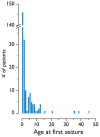The natural history of epilepsy in tuberous sclerosis complex
- PMID: 20041940
- PMCID: PMC3065368
- DOI: 10.1111/j.1528-1167.2009.02474.x
The natural history of epilepsy in tuberous sclerosis complex
Abstract
Background: Although epilepsy affects most patients with tuberous sclerosis complex (TSC), little is known about the natural history of epilepsy in this genetic disease.
Methods: A retrospective chart review of all patients with TSC seen between January 2002 and October 2008. Charts were reviewed for a history of infantile spasms (IS), seizure other than IS, refractory epilepsy, Lennox-Gastaut syndrome (LGS), anticonvulsant medication use, ages of seizure onset, last seizure, last clinic visit, clinical seizure phenotype(s), cognitive impairment, and genetic mutation.
Results: Two hundred ninety-one patients were included. Among these patients, 37.8% had a history of IS; 85.2% had a history of seizure; 54.1% developed multiple seizure types, not including IS; 63.2% had seizure onset in the first year of life; and 12.1% of adults without a seizure history developed epilepsy. Of epilepsy patients, 62.5% developed refractory epilepsy and 33.5% achieved epilepsy remission; 37.5% of these patients achieved medication freedom. IS was a risk factor for refractory epilepsy (p<0.0001) and LGS (p<0.0001). History of seizure, IS, age at seizure onset, and refractory epilepsy each correlated with poor cognitive outcome (p<0.0001). Epilepsy remission correlated with better cognitive outcome (p<0.0001). TSC2 was a risk factor for IS and epilepsy; patients without an identified mutation were more likely to achieve remission.
Conclusion: Most patients with TSC develop epilepsy and most develop multiple seizure types. Onset typically occurs in the first year of life; however, adults remain at risk. Although refractory epilepsy is common, many patients achieve seizure control. Many features of seizure history are predictive of cognitive and epilepsy outcome.
Conflict of interest statement
Disclosure: None of the authors has any conflicts of interest to report.
Figures


Comment in
-
Can we change the course of epilepsy in tuberous sclerosis complex?Epilepsia. 2010 Jul;51(7):1330-1. doi: 10.1111/j.1528-1167.2010.02528.x. Epilepsia. 2010. PMID: 20636971 No abstract available.
References
-
- Astrinidis A, Henske EP. Tuberous sclerosis complex: linking growth and energy signaling pathways with human disease. Oncogene. 2005;24:7475–7481. - PubMed
-
- Berg AT, Vickrey BG, Testa FM, Levy SR, Shinnar S, DiMario F, Smith S. How long does it take for epilepsy to become intractable? A prospective investigation. Ann Neurol. 2006;60:73–79. - PubMed
-
- Crino PB. Molecular pathogenesis of tuber formation in tuberous sclerosis complex. J Child Neurol. 2004;19:716–725. - PubMed
-
- Crino PB, Nathanson KL, Petri Henske E. The tuberous sclerosis complex. N Engl J Med. 2006;355:1345–1356. - PubMed
-
- Cross JH. Neurocutaneous syndromes and epilepsy—issues in diagnosis and management. Epilepsia. 2005;46:17–23. - PubMed
Publication types
MeSH terms
Grants and funding
LinkOut - more resources
Full Text Sources
Other Literature Sources
Medical

